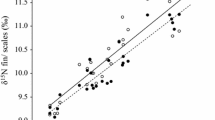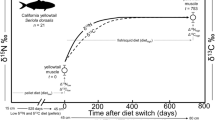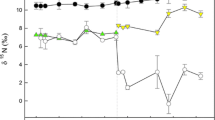Abstract
Stable isotopes can illuminate resource usage by organisms, but effective interpretation is predicated on laboratory validation. Here we develop stable isotope clocks to track resource shifts in anadromous rainbow trout (Oncorhynchus mykiss). We used a diet-switch experiment and model fitting to quantify N stable isotope (δ15N) turnover rates and discrimination factors for seven tissues: plasma, liver, fin, mucus, red blood cells, muscle, and scales. Among tissues, diet-tissue δ15N discrimination factors ranged from 1.3 to 3.4 ‰. Model-supported tissue turnover half-lives ranged from 9.0 (fin) to 27.7 (scale) days. We evaluated six tissue turnover models using Akaike’s information criterion corrected for small sample sizes. The use of equilibrium tissue values was supported in all tissues and two-compartment models were supported in plasma, liver, and mucus. Using parameter estimates and their uncertainty we developed stable isotope clocks to estimate the time since resource shifts. Longer turnover tissues provided accurate estimates of time since resource switch for durations approximately twice their half-life. Faster turnover tissues provided even higher precision estimates, but only within their half-life post-switch. Averaging estimates of time since resource shift from multiple tissues provided the highest precision estimates of time since resource shift for the longest duration (up to 64 days). This study therefore provides insight into physiological processes that underpin stable isotope patterns, explicitly tests alternative models, and quantifies key parameters that are the foundation of field-based stable isotope analysis.





Similar content being viewed by others
References
Bauchinger U, McWilliams S (2009) Carbon turnover in tissues of a passerine bird: allometry, isotopic clocks, and phenotypic flexibility in organ size. Physiol Biochem Zool 82:787–797
Boecklen WJ, Yarnes CT, Cook BA, James AC (2011) On the use of stable isotopes in trophic ecology. Annu Rev Ecol Evol Syst 42:411–440
Buchheister A, Latour RJ (2010) Turnover and fractionation of carbon and nitrogen stable isotopes in tissues of a migratory coastal predator, summer flounder (Paralichthys dentatus). Can J Fish Aquat Sci 67:445–461
Burnham KP, Anderson DR (2002) Model selection and multi-model inference: a practical information-theoretic approach, 2nd edn. Springer, New York
Cambray JA (2003) Impact on indigenous species biodiversity caused by the globalisation of alien recreational freshwater fisheries. Hydrobiologia 500:217–230
Carleton SA, Martínez del Rio C (2010) Growth and catabolism in isotopic incorporation: a new formulation and experimental data. Funct Ecol 24:805–812
Carleton SA, Kelly L, Anderson-Sprecher R, Martínez del Rio C (2008) Should we use one-, or multi-compartment models to describe 13C incorporation into animal tissues? Rapid Commun Mass Spectrom 22:3008–3014
Caut S, Angulo E, Courchamp F (2009) Variation in discrimination factors (Δ15 N and Δ13C): the effect of diet isotopic values and applications for diet reconstruction. J Appl Ecol 46:443–453
Cerling TE, Ayliffe LK, Dearing MD, Ehleringer JR, Passey BH, Podlesak DW, Torregrossa A-M, West AG (2007) Determining biological tissue turnover using stable isotopes: the reaction progress variable. Oecologia 151:175–189
Church MR, Ebersole JL, Rensmeyer KM, Couture RB, Barrows FT, Noakes DLG (2009) Mucus: a new tissue fraction for rapid determination of fish diet switching using stable isotope analysis. Can J Fish Aquat Sci 66:1–5
Deniro MJ, Epstein S (1981) Influence of diet on the distribution of nitrogen isotopes in animals. Geochim Cosmochim Acta 45:341–351
Essington TE, Kitchell JF, Walters CJ (2001) The von Bertalanffy growth function, bioenergetics, and the consumption rates of fish. Can J Fish Aquat Sci 58:2129–2138
Gannes LZ, O’Brien DM, Martínez del Rio C (1997) Stable isotopes in animal ecology: assumptions, caveats and a call for more laboratory experiments. Ecology 78:1271–1276
Gannes LZ, Martínez del Rio C, Koch P (1998) Natural abundance variations in stable isotopes and their potential uses in animal physiological ecology. Comp Biochem Physiol 119:725–737
Guelinckx J, Maes J, Van Den Driessche P, Geysen B, Dehairs F, Ollevier F (2007) Changes in δ13C and δ15 N in different tissues of juvenile sand goby Pomatoschistus minutus: a laboratory diet-switch experiment. Mar Ecol Prog Ser 341:205–215
Gustafson RG, Waples RS, Myers JM, Weitkamp LA, Bryant GJ, Johnson OW, Hard JJ (2007) Pacific salmon extinctions: quantifying lost and remaining diversity. Conserv Biol 21:1009–1020
Hayes SA, Bond MH, Hanson CV, Jones AW, Ammann AJ, Harding JA, Collins AL, Perez J, Macfarlane RB (2011) Down, up, down and “smolting” twice? Seasonal movement patterns by juvenile steelhead (Oncorhynchus mykiss) in a coastal watershed with a bar closing estuary. Can J Fish Aquat Sci 68:1341–1350
Herzka SZ, Holt SA, Holt GJ (2001) Documenting the settlement history of individual fish larvae using stable isotope ratios: model development and validation. J Exp Mar Biol Ecol 265:49–74
Hesslein R, Hallard K, Ramlal P (1993) Replacement of sulfur, carbon, and nitrogen in tissue of growing broad whitefish (Coregonus nasus) in response to a change in diet traced by δ34S, δ13C, and δ15N. Can J Fish Aquat Sci 50:2071–2076
Hobson KA, Clark RG (1992) Assessing avian diets using stable isotopes I: turnover of 13C in tissues. Condor 94:181–188
Klaassen M, Piersma T, Korthals H, Dekinga A, Dietz MW (2010) Single-point isotope measurements in blood cells and plasma to estimate the time since diet switches. Funct Ecol 24:796–804
Koch PL, Fogel ML, Tuross N (1994) Tracing the diets of fossil animals using stable isotopes. In: Lajtha K, Michener RH (eds) Stable isotopes in ecology and environmental science. Blackwell, Boston, pp 63–92
Kurle CM (2009) Interpreting temporal variation in omnivore foraging ecology via stable isotope modelling. Funct Ecol 23:733–744
Layman CA, Araujo MS, Boucek R, Hammerschlag-Peyer CM, Harrison E, Jud ZR, Matich P, Rosenblatt AE, Vaudo JJ, Yeager LA, Post DM, Bearhop S (2012) Applying stable isotopes to examine food-web structure: an overview of analytical tools. Biol Rev 87:545–562
Logan J, Haas H, Deegan L, Gaines E (2006) Turnover rates of nitrogen stable isotopes in the salt marsh mummichog, Fundulus heteroclitus, following a laboratory diet switch. Oecologia 147:391–395
MacAvoy SE, Macko SA, Arneson LS (2005) Growth versus metabolic tissue replacement in mouse tissues determined by stable carbon and nitrogen isotope analysis. Can J Zool 83:631–641
Martínez del Rio C, Anderson-Sprecher R (2008) Beyond the reaction progress variable: the meaning and significance of isotopic incorporation data. Oecologia 156:765–772
Martínez del Rio C, Wolf BO (2005) Mass-balance models for animal isotopic ecology. In: Starck MJ, Wang T (eds) Physiological and ecological adaptations to feeding in vertebrates. Science Publishers, Enfield
Martínez del Rio C, Wolf N, Carleton SA, Gannes LZ (2009) Isotopic ecology ten years after a call for more laboratory experiments. Biol Rev 84:91–111
McCutchan JH, Lewis WM, Kendall C, McGrath CC (2003) Variation in trophic shift or stable isotope ratios of carbon, nitrogen and sulphur. Oikos 102:378–390
McIntyre PB, Flecker AS (2006) Rapid turnover of tissue nitrogen of primary consumers in tropical freshwaters. Oecologia 148:12–21
Moyle PB (2002) Inland fishes of California. University of California Press, Berkeley
Newsome SD, Clementz MT, Koch PL (2010) Using stable isotope biogeochemistry to study marine mammal ecology. Mar Mammal Sci 26:509–572
Oppel S, Powell AN (2010) Carbon isotope turnover in blood as a measure of arrival time in migratory birds using isotopically distinct environments. J Ornithol 151:123–131
Ott RL (1993) An introduction to statistical methods and data analysis, 4th edn. Duxbury, Belmont
Pearson SF, Levey DJ, Greenberg CH, Martínez del Rio C (2003) Effects of elemental composition on the incorporation of dietary nitrogen and carbon isotopic signatures in an omnivorous songbird. Oecologia 135:516–523
Phillips DL, Eldridge PM (2006) Estimating the timing of diet shifts using stable isotopes. Oecologia 147:195–203
Pinnegar JK, Polunin NVC (1999) Differential fractionation of δ13C and δ15N among fish tissues: implications for the study of trophic interactions. Funct Ecol 13:225–231
Podlesak DW, Mcwilliams SR, Hatch KA (2005) Stable isotopes in breath, blood, feces and feathers can indicate intra-individual changes in the diet of migratory songbirds. Oecologia 142:501–510
R Development Core Team (2008) R: a language and environment for statistical computing. R Foundation for Statistical Computing, Vienna
Richards FJ (1959) A flexible growth function for empirical use. J Exp Bot 10:290–300
Studds CE, Kyser TK, Marra PP (2008) Natal dispersal driven by environmental conditions interacting across the annual cycle of a migratory songbird. Proc Natl Acad Sci 105:2929–2933
Tieszen LL, Boutton TW, Tesdahl KG, Slade NA (1983) Fractionation and turnover of stable carbon isotopes in animal tissues: implications for δ13C analysis of diet. Oecologia 57:32–37
Acknowledgements
We are grateful for support from Susan Sogard, without which this project would not have been possible. We thank Sora Kim and Paul Koch for discussions on stable isotope analysis, as well as Stephan Munch, Mark Novak, Peter Raimondi, and Andrew Shelton for discussions regarding data analysis. We thank Mark Carr, Craig Layman, Carlos Martínez del Rio, Joseph Merz and an anonymous reviewer for their helpful comments on the manuscript. We thank Erick Sturm for facilities support, and Dyke Andreasen, Nicolas Retford, Cristina Cois, and Ashley Lila Pearson for assistance in the laboratory. W. N. H. was partially funded by a CALFED SeaGrant Fellowship (R/SF-11) during this research.
Author information
Authors and Affiliations
Corresponding author
Additional information
Communicated by Craig Layman.
Electronic supplementary material
Below is the link to the electronic supplementary material.
Rights and permissions
About this article
Cite this article
Heady, W.N., Moore, J.W. Tissue turnover and stable isotope clocks to quantify resource shifts in anadromous rainbow trout. Oecologia 172, 21–34 (2013). https://doi.org/10.1007/s00442-012-2483-9
Received:
Accepted:
Published:
Issue Date:
DOI: https://doi.org/10.1007/s00442-012-2483-9




